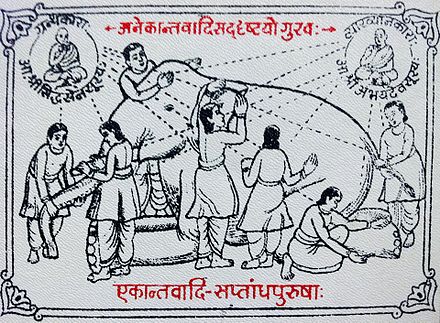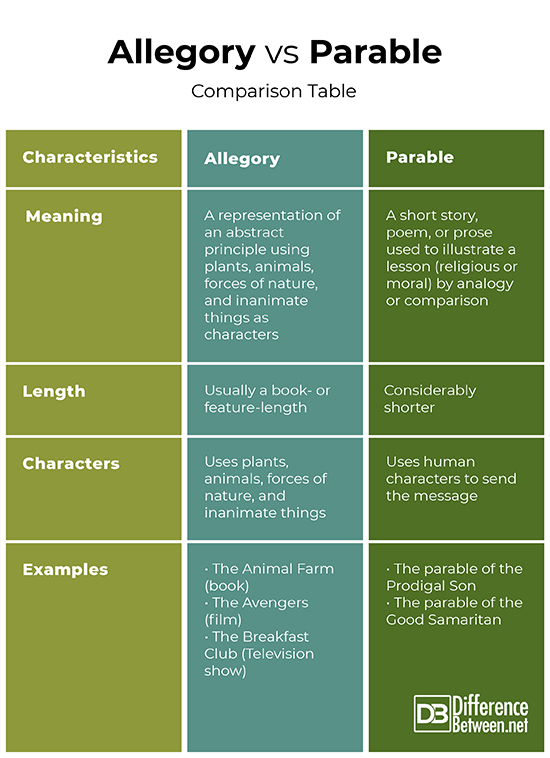Both allegory and parable are stylistic devices used in works of literature. The two are used to achieve the highest or richest styles of presenting hidden messages without being overly all-telling. Even though the two are usually misconceived to mean the same or have a relationship, there exist major differences between them.

What is an Allegory?
An allegory is a simple story, poem, or image whose interpretation can be used to reveal a hidden meaning. The usual lessons in allegories include moral or political ones and require a deeper analysis and interpretation of the piece of work.
An allegory is typically considered to be in the same line with “moral of a story”. It’s usually exciting and uses characters or events to send hidden messages or meanings across. The basic characteristic of an allegory is that it does not just come out and reveal the moral of a story.
Characteristics of an Allegory
- It is a simple poem, story, or prose that can be read at a metaphorical or literal level.
- When used by religious writers, it is used for teaching principles of a faith.
- When used by ethical writers, it is used to inculcate the morals the writers want to send to their reader’s hearts.
- It is used to aid in getting the point of view across if used by satirists in a social or political nature.
Types of Allegories
The different types of allegories are:
- Modern allegory
- Medieval allegory
- Biblical allegory
- Classical allegory
Some of the renown allegories in Literature include:
- The George Orwell’s book Animal Farm is a relevant political allegory that revolves around the 1917 Russian Revolution and rise of communism. The allegory is delivered using animals by depicting how different classes in the society view each other and the coldness between them. It also brings out the common modern-day slavery carried out on the weaker members of the society by the powerful ones (politicians).
- Yann Martel’s Beatrice and Virgil has also been used as an allegory. Yann tries to bring out the monumental pain and suffering of the victims of the Holocaust through writing.

What is a Parable?
A parable is defined as a simple story that is used to illustrate spiritual or moral lessons. The most common application of the style is the way Jesus told stories in the Gospels with hidden spiritual lessons.
Characteristics of a Parable
- It is a short tale or simple narrative.
- It illustrates a universal truth.
- It is used to sketch a setting, draw an action, and show results.
- It involves a character facing a moral dilemma or one who has made a bad decision and suffers from the unintended and unforeseen circumstances.
- It expresses abstract points of argument using concrete narratives.
Examples of parables in the Bible include:
- The parable of the Sower.
- The parable of the Weeds.
- The parable of the Yeast.
- The parable of the Mustard Seed.
- The parable of the Hidden Treasure.
Difference between Allegory and Parable
Some of the striking differences between an allegory and parable are:
Meaning of Allegory Vs. Parable
An allegory is a literary device used as a metaphor and uses a place, character, or event to send a broader message or moral lesson about a real-world issue or occurrence. A parable, conversely, is defined as a brief and direct to the point story, verse, or prose used to illustrate a single or more instructive principle or lesson.
Characters in Allegories Vs. Characters in Parables
An allegory uses plants, animals, forces of nature, and inanimate things as characters to tell a story while parables use human characters to tell their story or the moral lesson of a story.
The etymology of Allegory Vs. Parable
Etymology was first attested in the English Literature field in 1382. The word comes from the Latin version allegory which is a Latinization of a Greek word ἀλληγορία (allegoría) which means a veiled or figurative language. The Greek version, in turn, comes from ἄλλος (allos) and ἀγορεύω (agoreuo).
Conversely, the word parable comes from the Greek word παραβολή (parabolē) which means comparison, illustration, and analogy. The name was given by Greek rhetoricians who used it to give illustrations in the form of brief fictional narratives.
Examples of Allegory Vs. Parables
Some of the most popular allegories include in George Orwell’s book Animal Farm where it is used to reflect the different classes in a society. The other one is the Yann Martel’s Beatrice and Virgil where it is used to bring out the monumental pain and suffering of the Holocaust victims.
Some of the most common parables include The Parable of the Sower and the Parable of the Mustad Seed, both from the Bible.
Allegory Vs. Parable: Comparison Table

Summary of Allegory Vs. Parable
In the world of literature, poetry, and prose, some of the terms you will not miss are allegory and parable. They both perform the role of revealing any hidden messages in the literary piece. Also, despite being different, an allegory and parable are used for identifying and bringing out the moral lesson in a piece of art.
- Difference Between Minecraft and Terraria - August 7, 2020
- Difference Between Alliteration and Onomatopoeia Poems - July 25, 2019
- Difference Between Certification and Licensure - July 24, 2019


The clearest distinction between an allegory and a parable was made in the original edition of A Dictionary of Modern English Usage, H.W. Fowler
editor (1926). As Fowler distinguished them, parable is more condensed than allegory: a single principle comes to bear, and a single moral is deduced. A parable is usually an example of simile; an allegory is usually
an example of metaphor. In the example of parable cited in this article,
the audience can infer a direct connection between the subject of the
parable of the Good Samaritan and their behavior, thus there is a simile,
a comparison of two different things, Samaritans (dwellers in Samaria)
and Jews being antipathetic to one another. Animal Farm, as noted, is
an allegory using metaphor, the various creatures in the narrative not
being a direct comparison, but figures used in place of human characteristics. The other examples of allegory in the comparison table
don’t even accord with the description of allegory — The Avengers includes
humans who have enhanced abilities, either by design (Iron Man, Captain America) or by accident (the Hulk). Some of the Avengers are simply skilled, with no enhanced abilities (Black Widow, Hawkeye). So the Avengers doesn’t employ “plants, animals, forces of nature, and inanimate things” as its characters. Ditto The Breakfast Club. BTW, The Breakfast Club isn’t even a narrative, it’s a chat show with music.
Reply